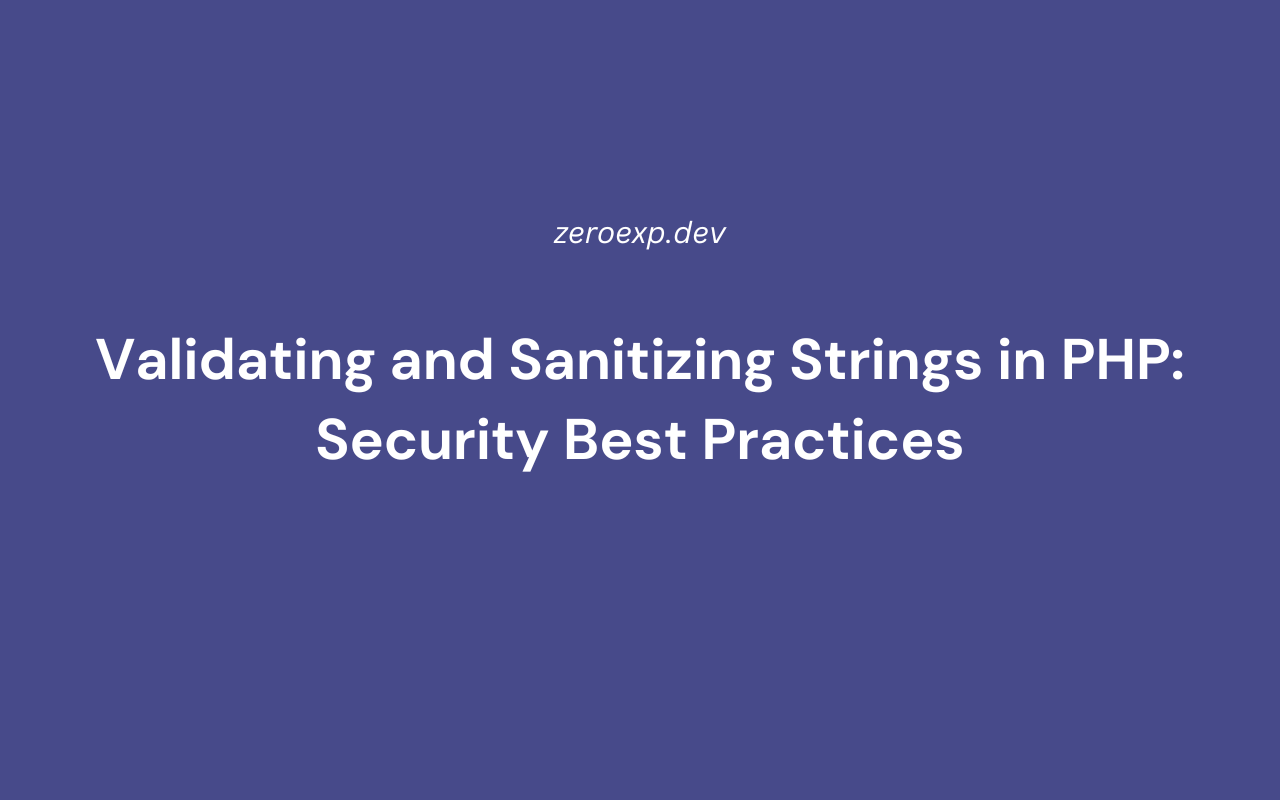Learn how to validate and sanitize strings in PHP to prevent security vulnerabilities like SQL injection and XSS. Use built-in PHP functions for safe input handling.
Introduction
Handling user input securely is a critical aspect of web development. Improper input validation and sanitization can expose applications to serious security risks, including SQL injection, cross-site scripting (XSS), and code injection attacks.
To ensure safe and reliable data handling, PHP provides built-in functions for:
- Validating input to ensure it meets expected formats
- Sanitizing input to remove unwanted characters or malicious code
- Preventing security vulnerabilities like XSS and SQL injection
This guide covers:
- The difference between validation and sanitization
- PHP functions for safe string handling
- Preventing SQL injection and XSS attacks
- Best practices for secure input validation
1. Understanding Validation vs. Sanitization
Validation and sanitization are two distinct processes:
- Validation: Ensures data meets specific criteria (e.g., valid email, correct format).
- Sanitization: Modifies input to remove unwanted characters while keeping it functional.
Example: Validating an email ensures it follows a correct format, while sanitizing removes unnecessary spaces or harmful content.
2. Validating Strings with filter_var()
PHP’s filter_var() function can validate strings against predefined filters.
Validating Email Addresses
$email = "user@example.com";
if (filter_var($email, FILTER_VALIDATE_EMAIL)) {
echo "Valid email";
} else {
echo "Invalid email";
}
- Ensures the email has a proper structure (
user@domain.com). - Returns
falsefor invalid emails.
Validating URLs
$url = "https://example.com";
if (filter_var($url, FILTER_VALIDATE_URL)) {
echo "Valid URL";
} else {
echo "Invalid URL";
}
- Prevents users from injecting malicious links.
Validating Integer and Float Values
$age = "25";
if (filter_var($age, FILTER_VALIDATE_INT)) {
echo "Valid integer";
} else {
echo "Invalid integer";
}
- Ensures input is a numeric integer.
$price = "19.99";
if (filter_var($price, FILTER_VALIDATE_FLOAT)) {
echo "Valid float";
} else {
echo "Invalid float";
}
- Useful for validating decimal values, such as product prices.
3. Sanitizing Strings to Remove Unsafe Characters
filter_var() also provides sanitization filters to remove harmful input.
Removing HTML Tags to Prevent XSS
$input = "<script>alert('Hacked!');</script> Welcome!";
$clean = filter_var($input, FILTER_SANITIZE_STRING, FILTER_FLAG_NO_ENCODE_QUOTES);
echo $clean; // Output: Welcome!
- Strips out HTML tags, preventing XSS attacks.
Sanitizing Email Addresses
$email = "user<>@example.com";
$cleanEmail = filter_var($email, FILTER_SANITIZE_EMAIL);
echo $cleanEmail; // Output: user@example.com
- Removes invalid characters from the email.
Sanitizing URLs
$url = "https://example.com<script>";
$cleanUrl = filter_var($url, FILTER_SANITIZE_URL);
echo $cleanUrl; // Output: https://example.com
- Ensures the URL contains only valid characters.
Removing Unwanted Characters from Usernames
$username = "john_doe!@#$%";
$cleanUsername = preg_replace("/[^a-zA-Z0-9_]/", "", $username);
echo $cleanUsername; // Output: john_doe
- Allows only letters, numbers, and underscores in usernames.
4. Preventing SQL Injection with Prepared Statements
Using raw user input in SQL queries is dangerous and can lead to SQL injection attacks.
Vulnerable SQL Query (Do Not Use)
$search = $_GET['search'];
$query = "SELECT * FROM users WHERE name = '$search'"; // Dangerous!
An attacker can inject SQL commands:
?search=' OR '1'='1
This could allow access to all records in the database.
Secure Query Using Prepared Statements
$pdo = new PDO("mysql:host=localhost;dbname=testdb", "user", "password");
$stmt = $pdo->prepare("SELECT * FROM users WHERE name = :name");
$stmt->bindParam(":name", $search, PDO::PARAM_STR);
$stmt->execute();
- Prevents SQL injection by treating input as data, not code.
5. Preventing Cross-Site Scripting (XSS) with htmlspecialchars()
XSS attacks occur when malicious JavaScript is injected into a webpage.
Vulnerable Code (Do Not Use)
$comment = $_POST['comment'];
echo "User says: " . $comment;
If a user enters:
<script>alert('Hacked!');</script>
The page will execute the script, causing a security risk.
Secure Version Using htmlspecialchars()
$comment = htmlspecialchars($_POST['comment'], ENT_QUOTES, 'UTF-8');
echo "User says: " . $comment;
- Converts
<script>into harmless text instead of running it.
6. Best Practices for Secure String Handling
✅ Always validate input using filter_var() before processing it.
✅ Sanitize input to remove unwanted characters and prevent attacks.
✅ Use prepared statements in SQL queries instead of raw input.
✅ Escape HTML output using htmlspecialchars() to prevent XSS.
✅ Limit input length to prevent buffer overflow attacks.
✅ Avoid eval() and exec() – Never execute user-supplied code.
✅ Log suspicious activity to detect possible attacks early.
Conclusion
Validating and sanitizing strings in PHP is essential to prevent security vulnerabilities and ensure data integrity.
This guide covered:
- Validating input with
filter_var() - Sanitizing input to remove unsafe characters
- Preventing SQL injection with prepared statements
- Mitigating XSS attacks using
htmlspecialchars()
By following these best practices, you can protect your PHP applications from common security threats while maintaining clean, reliable user input handling.
